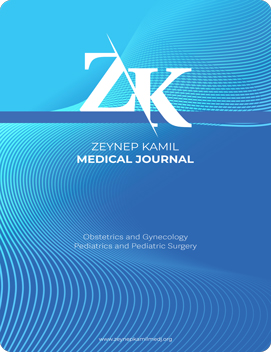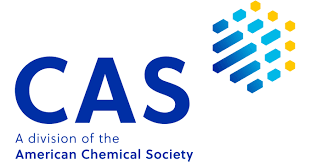Quick Search
Volume: 50 Issue: 2 - 2019
| ORIGINAL RESEARCH | |
| 1. | Correlation of Insulin Resistance with Hormonal Parameters in Polycystic Ovary Sydrom Patients Regarding to Obesity Hasan Süt, Cem Terece, Sevcan Arzu Arinkan, MURAT MUHCU doi: 10.16948/zktipb.468810 Pages 1 - 4 INTRODUCTION: The aim of our study was to investigate the correlation between insulin resistance and hormonal parameters of insulin resistance on the non-obese and obese patients with polycystic ovary syndrome (PCOS). METHODS: 78 women patient with age range 21 to 40 diagnosed with PCOS based on the clinical and endocrine features were included to our study. PCOS was diagnosed according to the reviewed Rotterdam criteria. PCOS patients were studied in two groups: Obese patients (the patients that body mass indexes over 25) non-obese patients (the patients that body mass indexes under 25). RESULTS: It has been detected, fasting insulin, total testosterone and HbA1c levels were significantly higher and also HDL level was significantly lower in the obese group. Besides, QUICKI and fasting glucose / fasting insulin level have been detected significantly low, HOMA-IR was significantly higher in the obese group.In the non-obese group LH / FSH ratio is correlated with HOMA-IR and QUICKI and also total testosterone levels are correlated with QUICKI. Besides, it has been noted that the insulin resistance is not correlated with FSH level. PCOS patients Impaired glucose tolerance and the prevalence of DM are 5 times greater than the general population. PCOS is seen more frequently in type 2 DM patients. DISCUSSION AND CONCLUSION: We suggest insulin resistance screening in all PCOS patients. However, if this is not possible, at least all patients that VKI levels over 25, should be screened. We think that, LH level in obese patients with PCOS is important to predict the insulin resistance. |
| 2. | The Evaluation of Cervical Smear Results Assessed by ThinPrep and Conventional Methods Resul Arisoy, Necip Cihangir Yılanlıoglu, Koray Özbay, Altug Semiz, Alparslan Deniz doi: 10.16948/zktipb.556517 Pages 5 - 8 INTRODUCTION: Our aim was to evaluate cervical smear results according to years and patient age. We investigated the abnormal outcome rates and distribution to determine whether there is any difference in smear results according to the examination method used and to contribute to the epidemiological data of our country. METHODS: We retrospectively analyzed the cervical smear test results of the patients who were admitted to gynecology outpatient clinic of Şişli Memorial Hospital between June 2010 and December 2014. 32.617 patients aged 21-65 years were included in our study. RESULTS: The pathology result was determined to be normal in 29.831 patients (91.5%). ASCUS, ASC-H and AGC were detected in 1.713 (5.25%), 135 (0.4%) and 21 (0.06%) patients respectively. LSIL was detected in 767 cases (2.35%), HSIL in 131 cases (0.4%), adeno cancer in three cases and squamous cancer in two cases. When all the cases were evaluated, the rate of abnormal results was found to be 8.5%. LSIL (35.9 ± 8.0 years) and HSIL (34.4 ± 7.2 years) were detected at significantly younger ages. DISCUSSION AND CONCLUSION: In our study, we detected an increase in the prevalence of precancerous lesions in years by ThinPrep method. |
| 3. | Comparison of Depression, Anxiety and Somatization Values Between Adolescents and Children who Presenting Stomach Pain Merve Teken, Melek Gözde Luş, Saziye Senem Basgul doi: 10.16948/zktipb.500381 Pages 9 - 14 INTRODUCTION: We determined the levels of depression, anxiety and somatization of children with a complaint of abdominal pain who has a physical causes and not. METHODS: The sample is 48 children aged 8-15 years who were admitted to the pediatric ward of a private hospital with a complaint of abdominal pain whose physical causes were found in 24. In this study, the Sociodemographic Data Form, Depression Scale for Children (CES-DC), The Pediatric Anxiety Rating Scale (PARS), and Children's Somatization Inventory-24 (CSI-24) were used. RESULTS: The statistical analyses of the findings show that there are no statistical differences between the patients with physical pain and anxiety and depression, anxiety and somoization values. DISCUSSION AND CONCLUSION: The results of these findings were discussed within the scope of literature. |
| 4. | Correlation Between Colposcopic Biopsy and Excisional Procedure Results in Patients with HGSIL Cytology: 10-Years Experience of A Tertiary Referral Centre Baki Erdem, Osman Ascioglu, Gökçe Turan, Ilkbal Temel Yuksel, Osman Samet Gunkaya, İpek Yıldız Özaydın, Isil Safak Yildirim, DOĞUKAN YILDIRIM, özgür akbayır doi: 10.16948/zktipb.460069 Pages 15 - 18 INTRODUCTION: To evaluate the correlation between pathology results obtained by colposcopic biopsy and excisional procedures in cases with a cytology of high grade cervical intraepithelial lesion (HGSIL). METHODS: A total of 282 patients' data were collected. All patients underwent colposcopic examination. Twenty-three patients with a diagnosis of colposcopic biopsy-proven invasive cancer were clinically staged, and appropriate treatment was planned (radical hysterectomy or chemoradiotherapy). Excisional procedures were executed in all other patients (n=259). The highest grade pathology obtained by biopsy or excisional procedures was recorded as the definitive final pathology. RESULTS: The agreement rate was 73.7% (n = 191/259) between the colposcopic biopsy and excisional procedures. 64 patients had ≤CIN1 (22.7%), and overtreatment was found in this group. 63.5% of the patients (n = 179) were CIN2 +, and 13.8% (n = 39) were invasive cancer. Colposcopic biopsy ended up with an incorrect pathologic diagnosis in 41% (n = 16/39) of patients with invasive cancer. The kappa analysis was performed to determine the correlation between pathology results obtained by colposcopic biopsy and excisional procedures. κ is calculated to be 0.542, which means that the correlation was moderate. DISCUSSION AND CONCLUSION: It was determined that there were approximately three-quarters of agreement between colposcopic biopsy and excisional procedure results in patients with HGSIL cytology. Because of the high incidence of CIN2 + and invasive cancer in this group, we believe that it would be reasonable and safe to choose the excisional procedure option even if the biopsy result remains ≤ CIN1. |
| 5. | The Influence of Spontaneous and Induced Labor in Maternal and Fetal Outcomes in Preterm Premature Rupture of Membranes Gurcan Turkyilmaz, Şebnem Erol Turkyilmaz, Mesut Polat, Enis Özkaya, Murat Api doi: 10.16948/zktipb.541187 Pages 19 - 23 INTRODUCTION: We evaluated the effect of spontaneous and induced parturition in maternal and fetal outcomes in preterm prematüre rupture of membranes (PPROM) and analyzed the influence of the latent period in these results. METHODS: We analyzed the results of patients who were complicated with PPROM in 24-34 weeks of gestation between January 2014-January 2016 in our clinic. RESULTS: We collected 93 cases and in 43 patients (46%) the labor occurs spontaneously (Group 1) and in 50 cases (54%) we induced the labor due to maternal and fetal indications (Group 2). The interval between when PPROM occurred, and labor was 5.8±2.1 days in group 1 and 8.3±3.5 days in group 2 (p: 0,19). There was no significant difference between birthweights in two groups. C-section was performed in 19 (%44.1) patients in group 1 and 37 (%74) cases were delivered by C-section in group 2 (p: 0.03). Neonatal mortality was 9.3% in group 1 and 6% in group 2 (p: 0.54). Severe morbidity was detected in 14 (%32.5) patients in group 1 and 17 (%34)in group 2. We did not show a significant effect of latency period into the severe morbidity and mortality in newborns (p: 0.54, p: 0.67). DISCUSSION AND CONCLUSION: There was no relevant effect of latency period into the neonatal outcomes, and expectant management should be used in PPROM cases if the maternal and fetal status is reassuring. |
| 6. | Relationship of Development of Gestational Diabetes Mellitus Between HbA1c Valide and Abnormal Thyroid Function Tests in Pregnant Women Sengul AYDIN YOLDEMIR, İsmet Kılıç doi: 10.16948/zktipb.415959 Pages 24 - 27 INTRODUCTION: Thyroid disease is the second most common endocrine disease to affect women of reproductive age. Gestational Diabetes Mellitus is defined as glucose intolerance that comes out or is first recognized during pregnancy, and disappears after delivery. And the incidence is increasing. Thyroid function tests disorder and high HbA1c value which detected in early pregnancy, that the whether there is a risk factors for developing GDM in later stages of pregnancy. METHODS: Eighty-two women in weeks 6-20 of pregnancy attending the internal medicine clinics and the Obstetrics and Gynaecology Clinics of Merzifon Karamustafa Paşa Government Hospital between January 2013 and July 2013 were investigated retrospectively in this study. Serum levels of TSH, fT4, fT3, FBG, HbA1c and development of GDM were assessed in all cases. Statistical analyzes were performed using SPSS 15.0 software. P values <0.05 were considered statistically significant. RESULTS: Thyroid gland dysfunction was found 42 of all patients.Hypothyroidism was found 20 (%24.4) of cases and hyperthyroidism was found 22(%26.8) of them.The prevalence of family history was significantly higher in cases with thyroid dysfunction(p=0.01). 8(%9.8) of patients were diagnosed as impaired glucose tolerance and 5(%6.1) of them were diagnosed as gestational DM according to OGTT performed in 24-28 weeks of gestation. There was no significant difference in the prevalence of impaired glucose tolerance or gestational DM between two groups(p=0.0091). In addition, serum levels of fasting plasma glucose were higher in patients with thyroid gland dysfunction (p=0.0012). The mean levels of HbA1c were 5.9+0.64 in patients with thyroid gland disorder and 5.1+0.33 in control group. There was a significant difference between two groups (p< 0.05). The patients with HbA1c>6 in first trimester were found to be in higher risk for developing impaired glucose tolerance and gestational DM (p=0.03). DISCUSSION AND CONCLUSION: Thyroid gland disfunction and high HbA1c levels in early pregnancy can be evaluated as risk factors in developing GDM. Thus,we suggest that these patients should be screened carefully during pregnancy. |
| 7. | Prenatal and Postnatal Evaluation of Cases with Minor Fetal Abnormalities Dogan Vatansever, Gözde Yeşil, Burak Giray, Vedat Dayıcıoğlu doi: 10.16948/zktipb.541396 Pages 28 - 34 INTRODUCTION: Prenatal detection of minor abnormalities by fetal ultrasonographic examination are associated with increased aneuploidy risk. The aim of the study was to evaluate the prenatal and postnatal outcomes of cases with minor fetal abnormalities. METHODS: We reviewed 3833 women who had second-trimester ultrasonographic examination at Zeynep Kamil Research and Training Hospital, retrospectively. Three hundred sixty-nine women with fetal minor abnormalities were assigned to case group, 3464 women without fetal abnormality were assigned to control group. RESULTS: Two hundred ninety-five (79.95%) women had isolated fetal minor abnormality and 74 (20.05%) women had multiple minor abnormalities. There were 10 (3.4%) infants with trisomy 21, 1 (0.3%) infant with trisomy 18, 4 (1.4%) infants with cystic fibrosis, 2 (0.7%) infants with congenital cardiac anomalies, and 4 (1.4%) infants with congenital renal anomalies in the single minor fetal abnormality group. There were 7 (18.9%) infants with trisomy 21, 1 (2.7%) infant with trisomy 18, 3 (8.1%) infants with congenital cardiac anomalies, and 3 (8.1%) infants with congenital renal anomalies in cases with hyperechogenic foci in the fetal heart combined with any other minor markers. DISCUSSION AND CONCLUSION: There were statistically significant differences between the case group and control group with regard to aneuploidy. Isolated hyperechogenic bowel, isolated short femur-humerus and combination of hyperechogenic foci in the fetal heart, renal pyelectasis and hypoplasia of the nasal bone were associated with increased trisomy 21 risk. |
| 8. | Evaluation of ADHD Related Quality of Life in a Clinical Sample of Children and Adolescents Fahri Çelebi, Dilek Unal doi: 10.16948/zktipb.495103 Pages 35 - 38 INTRODUCTION: Attention Deficit Hyperactivity Disorder (ADHD) is a psychiatric disorder that interrupts functionality and impairs life quality. Our aim in this study is to determine the effect of ADHD related quality of life and the factors which may be related with the quality of life in children and adolescents who have ADHD. METHODS: 49 children and adolescents with a diagnosis of ADHD were included in this study. ADHD diagnosis was made in the first clinical interview according to DSM-V and Schedule for Affective Disorders and Schizophrenia for School-Age Children--Present and Lifetime Version(K-SADS-PL) was administered to assess the ADHD subtypes and comorbid psychiatric diagnoses. Socioeconomic status was determined by using the Hollingshead-Redlich scale. To assess the quality of life, ADHD quality of life scale (ADHD QoL) was used. Conners parent rating scale (CPRS) was filled by the parents of the children to investigate the severity of ADHD symptoms. RESULTS: The mean age of the patient group (12 girls/37 boys) was 11.15 (SD: 1.53). Mean total score of the CPRS was 44.59 ( SD: 18.8). According to the ADHD QoL scale, total home subscale mean score was 57.51(SD: 15.49) and total school subscale mean score was 57.97 (SD: 14.51). No significant relationship was found between the quality of life and age, sex, symptom severity and psychiatric comorbidities. DISCUSSION AND CONCLUSION: ADHD is a chronic disorder which has negative impact on daily life. It is important for clinicians not only to consider the clinical conditions and symptom severity, but also the impact of ADHD on life comfort while evaluating children and adolescents with ADHD. |
| 9. | Analysis of Consecutive 100 Patients Aged Between 0-3 Years Who were Consulted with The Orthopedics Department by Pediatrics Outpatient Clinic Recep ÖZTÜRK, Murat Yasin Gençoğlu, ÖMER FARUK ATEŞ, Mahmut Nedim Aytekin, Orçun Toktaş doi: 10.16948/zktipb.429353 Pages 39 - 43 INTRODUCTION: In this study, we aimed to analyze demographic data of the children aged between 0 and 3 years who were consulted with the orthopedics department by pediatrics outpatient clinic. METHODS: Ages, clinical findings, and radiologic examination outcomes of consecutive 100 patients who were consulted with the orthopedics department by pediatrics outpatient clinic between 2017 and 2018 were retrospectively studied. RESULTS: Of the 100 pediatric patients aged between 1 month and 36 months witha mean age of 17 months, 54 were girls and 46 were boys. Orthopedics clinic was consulted with 14 different presumed diagnoses. The most common cause of consultation was the presumed diagnosis of developmental hip dysplasia (44 patients). Developmental hip dysplasia was detected in 14 of the consulted children. The second most common presumed was in-toeing (25 patients). The other less frequent presumed diagnoses included congenital clavicular fracture (9 patients), torticollis (4 patients), pes equinovarus deformity (4 patients), o-bone (3 patients), noisy joints (2 patients), articular spasticity (2 patients), planovalgus, cellulitis, toe walking, sacral hirsutism, polydactylism, trigger finger, abd brachial plexus damage. DISCUSSION AND CONCLUSION: The most common orthopedic pathologies in the early childhood examination of pediatric patients aged between 0 and 3 years in pediatric clinic are developmental hip dysplasia and in-toeing, although clinicians should suspected of at least more than ten common orthopedic pathologies. |
| 10. | Evaluation of Obesity and Metabolic Status in Polycystic Ovary Syndrome in Fertile and Infertile Groups VUSLAT LALE BAKIR, Gul Karahan doi: 10.16948/zktipb.558143 Pages 44 - 48 INTRODUCTION: The aim of our study was to compare the BMI and metabolic values of fertile and infertile groups in patients with polycystic ovary syndrome (PCOS) and to determine the effect of obesity and metabolic status on fertility and infertile groups and the fertility effect of obesity. METHODS: The clinical and metabolic data of 230 patients who presented to the gynecology outpatient clinic of our hospital between 2013 and 2018 and were diagnosed with PCOS according to the Rotterdam Diagnosis Criteria were evaluated. Body mass index (BMI), waist ratio, menstrual period, fertility status, fertility duration, parity status, presence and degree of hirsutism were evaluated. 75 g oral glucose tolerance test (OGTT) was performed following appropriate diet and fasting period. Fasting glucose and insulin levels and insulin resistance cases were determined. Total cholesterol, HDL and LDL cholesterol levels were determined. Patients with BMI; The patients were divided into two groups as fertile and infertile, evaluated for obesity and metabolic data, and data on the relationship with BMI were calculated statistically. These metabolic disorders were compared to BMI and fertility status. RESULTS: The mean age of the patients was 26.7 years. The mean BMI was 28.92 ± 5.95 kg / m2. Only 25% of the patients had normal weight and 73% were overweight. 4 (1.7%) cases in the weak group with BMI less than 18.5, 58 (25.2%) cases in normal weight group with BMI 19-24.9, 71 (30.9%) in overweight group with BMI 25-29.9 There were 86 cases (37.4%) in obese group with BMI 30-39.9 and 11 cases (4.8%) in morbidly obese group with BMI of 40 and above. u (21.5%) is fertile. The duration of infertility ranged from 12 to 196 months, with a mean of 33.92 ± 24.25 months and a median of 24 months. The waist circumference is between 62 and 135 cm and the average is 87.76 ± 13.48 cm. The waist / hip ratio ranged from 0.65 to 0.98 and the mean was 0.80 ± 0.06. The distribution of BMI was similar in the fertile and infertile groups. 99 (43.1%) of the patients had insulin resistance, 77 (33.5%) had impaired glucose tolerance and 12 (5.2%) had DM. Mean blood lipid levels were not significantly different between fertile and infertile groups. The distribution of glucose metabolism disorders was similar in both groups. DISCUSSION AND CONCLUSION: Obesity and metabolic disorders are more common in PCOS cases. There was no significant difference between fertile and infertile groups according to BMI. |
| 11. | Perioperative and Postoperative Outcomes of Laparoscopy and Open Method for Surgical Staging of Endometrial Cancer Dogan Vatansever, Burak Giray, Yasmin Aboalhasan doi: 10.16948/zktipb.556016 Pages 49 - 53 INTRODUCTION: The aim of the study was to compare the safety of the laparoscopic and open method for endometrial cancer staging METHODS: Between January 2015 and August 2017, we reviewed 121 women with endometrial cancer treated by open (n=81) or laparoscopic (n=40) approach, retrospectively. Two groups were compared in terms of operating times, intraoperative and postoperative complications, perioperative and postoperative features such as hemoglobin values, the lengths of hospital stay, and adjuvant therapy. All of the patients underwent a hysterectomy and bilateral salpingo-oophorectomy; and when indicated, omentectomy and lymphadenectomy were performed. RESULTS: There were no significant differences between the two groups with regard to the number of parities, body mass index, menopausal status, age, the American Society of Anesthesiologists (ASA) scores, the requirement of lymphadenectomy, and hospital stay. There were significant statistical differences between groups in terms of operation time and difference of hemoglobin (p<0.001, p=0.013; respectively). Laparoscopic surgery had a longer operative time than laparotomy, and difference of hemoglobin in the laparotomy group is more than the laparoscopy group. Patients who underwent staging with laparotomy had bowel injury (1.2%), wound infection (13.6%), and postop ileus (8.6%) while in the laparoscopy group patients had wound infection (2.5%) and postop ileus (5%). There were no statistically significant differences between the two groups in terms of the intraoperative (p=1) and postoperative complications (p=0.101 for wound infection, p=0.716 for postop ileus). The groups were similar in terms of the histological grade, FIGO stage, histologic subtype, the rate of lymphovascular invasion, the depth of myometrial invasion, the total number of lymph nodes resected in lymph node dissections, the rate of lymph node metastasis, the location of the tumor, cervical stromal invasion, and the adjuvant therapy such as chemotherapy and brachytherapy. None of the patients in both groups had a recurrence and long-term lymphatic complication such as lymphocyst, lymphedema. DISCUSSION AND CONCLUSION: Our current data demonstrated that the laparoscopic approach can be performed without loss of safety with similar complication rates in patients with endometrium cancer. Additionally, the laparoscopy was not inferior to the laparotomy in terms of efficacy. |
| 12. | Retrospective Evaluation of Children Applying for Athlete Licenses Nilüfer Çetiner, Ibrahim Hakan Bucak, Habip Almiş, Fedli Emre Kılıç, Mehmet Turgut doi: 10.16948/zktipb.450625 Pages 54 - 58 INTRODUCTION: The numbers of children and adolescents taking part in sporting activities has risen increasingly in recent years, but sudden deaths occurring during matches or training are a cause for concern among families and in society. The purpose of the study was to seek an answer to the question of whether children should be evaluated by a pediatric cardiologist for sports licenses. METHODS: 168 children aged 7-17 who had newly started sporting activities or doing sport for some time were included in the study. Participants underwent a detailed physical examination and were assessed by a pediatric cardiologist. Athletes were examined using history, physical examination, 12-channel echocardiogram and echocardiography. Children with arrhythmia were investigated using 24-h Holter monitoring. RESULTS: 168 cases, 136 (81%) boys and 32 (19%) girls were enrolled. The mean age of the cases was 13 years. Pathology was determined in 4.1% of all subjects at electrocardiogram and in 11.9% at echocardiography. Effort tests were applied to 14 children with significant symptoms, in whom arrhythmia was determined or with a family history, 24-h rhythm Holter monitoring to five children and ambulatory Holter monitoring to one hypertensive child. Holter monitoring revealed frequent isolated monomorphic ventricular premature contraction in two subjects. Seven participants were eventually suspended from sporting activities. DISCUSSION AND CONCLUSION: National guidelines including presport cardiovascular evaluation have been developed in order to prevent sports-related sudden deaths. The main conclusion from our findings is that young children engaging in sports should be evaluated by a pediatric cardiologist before starting sporting activities. |
| 13. | Association Between Postpartum Depression and Synthetic Oxytocin Use for Postpartum Hemorrhage Prevention and Treatment Resul Karakus, ÇİĞDEM PULATOĞLU doi: 10.16948/zktipb.558732 Pages 59 - 63 INTRODUCTION: The aim of this study was to examine the relationship between postpartum synthetic oxytocin administration and the development of depressive and anxiety disorders after delivery. METHODS: We hypothesized that women exposed to postpartum exogenous oxytocin would have a reduced risk of postpartum depressive and anxiety disorders compared with those without exposure. The cases were examined under two groups as "Oxytocin users" (n = 100) and "Control" (n = 100) groups. Oxytocin group was given introvenous oxytocin just after the delivery for postpartum hemorrhage prevention and treatment. Questionnaires of depression and maternal anxiety were performed at the sixth week after the delivery. RESULTS: The incidence of depression (4%) in the oxytocin group was significantly lower than the control group (14%) (p: 0.026, p <0.05). Patients who do not use oxytocin have a 3.9-fold greater risk of developing depression. We identified a relationship between using oxytocin for postpartum hemorragie and decreased postpartum depressive symptoms. DISCUSSION AND CONCLUSION: Our findings suggest using exogenous oxytocin may contribute to postpartum symptoms of depression and anxiety among women. Future research should watch the longitudinal role of exogenous oxytocin in maternal mood and anxiety, the safety of high-dose long-term use of oxytocin. |
| 14. | Assesment of Female Sexual Function of Pregnant Women: Relation with Serum Androgens and Fetal Gender Bahar Sarıibrahim Astepe doi: 10.16948/zktipb.533351 Pages 64 - 69 INTRODUCTION: As a result of physical and hormonal changes during pregnancy sexual health of women affected significantly. METHODS: To evaluate sexual changes related to androgenic hormones and fetal gender in pregnant Turkish women RESULTS: There was a rate of 68% sexual dysfunction among Turkish pregnant women. The sexual dysfunction rate comprises the total and domain scores of FSFI throughout the pregnancy. Although the total and domain scores of FSFI did not differ between trimesters, orgasm domain scores were found to be decreasing with increasing gestational age. Along with an increase in total testosterone, the DHEAS level decreases with increasing gestational age. When the women with female fetus were evaluated for FSFI scores and androgen levels between trimesters, the mean level of total testosterone in third trimester was higher than the levels of first and second trimesters besides the mean level of DHEAS in the first trimester was higher than the levels of second and third trimesters. There was not any significant difference according to the androgen levels, FSFI total and domain scores between trimesters of the women with male fetus. DISCUSSION AND CONCLUSION: We found a high sexual dysfunction rate (68%) among pregnant Turkish women. The level of total testosterone, DHEAS and FSFI orgasm domain were found to be different between trimesters. Healthcare providers should provide more time for counseling about sexuality and encourage pregnant women to talk about sexual health and problems during antenatal visits. |
| CASE REPORT | |
| 15. | Vaginal Reflux in Childhood: Two Case Reports Ahmet Mithat Elmacı, Metin Gündüz, Hayrullah Alp doi: 10.16948/zktipb.450696 Pages 70 - 72 Vaginal reflux is defined as reflux of urine back into the vaginal vault during voiding. This condition is a type of lower urinary tract dysfunction commonly seen in prepubertal girls without structural abnormalities. The clinical presentation is diverse, varying from asymptomatic bacteriuria to recurrent urinary tract infections, and urinary incontinence. In this case report, we present two cases of vaginal reflux presented with urinary tract infection and urinary incontinence. The first patient was a 9-year-old girl with a complaint of recurrent urinary tract infection. Voiding cystourethrogram demonstrated retrograde filling of the vagina during early voiding phase. The second patient was 10 years old who had urinary incontinance and urinary tract ultrasonography revealed a collection of the vagina that disappeared after voiding. The patients were managed with toilet training, and remained free of symptoms afterwards. |
| 16. | PantoeaAgglomerans: A Rare Cause of Early Onset Neonatal Sepsis Aslı Okbay Güneş, Fatma Güliz Atmaca, Gonca Vardar, Elif Özalkaya, Caner Yürüyen, Hacer Aktürk, Güner Karatekin doi: 10.16948/zktipb.432653 Pages 73 - 74 Pantoea species, which are the members of Enterobacteriaceae family are gram-negative bacilli. It is identified as a rare cause of sepsis in neonatal intensive care units and found related to catheter or contaminated parenteral fluids. In this report, a preterm newborn who was infected with Pantoea agglomerans as a cause of early sepsis will be presented. In this case report, it is wanted to take attention that Pantoea agglomerans in preterm infants may be a rare cause of early neonatal sepsis and have a good prognosis. |
| REVIEW ARTICLE | |
| 17. | Preeclampsia, Maternal and Fetal Effects, Management, Interventions for Prevention and Nursing Role Meltem Uğurlu, Tülay Yavan doi: 10.16948/zktipb.358118 Pages 75 - 81 Preeclampsia remains a principal cause of maternal and fetal morbidity and mortality. In addition, it is responsible for 70,000 maternal deaths and 500,000 infant deaths annually. Preeclampsia poses a risk for some complications such as maternal renal insufficiency and liver involvement organ dysfunction or uteroplacental dysfunction and fetal growth restriction. The protective approaches for preeclampsia gain importance because maternal-fetal morbidity and mortality is high, and etiology and pathogenesis are not completely known. Nurses can play a critical role in diagnosis, assessment and management of women at risk for preeclampsia. It is highlighted in the studies that adequate antenatal care in terms of quality and quantity is beneficial for diagnosed with risky or mild preeclampsia women. Nurses need to know how to administer nursing care in the management of preeclampsia. In literature there are many studies about preeclampsia but there are few studies about preeclampsia and nursing care. It is thought that scientific studies in this subject will contribute to the preservation of maternal and neonatal health by providing quality nursing care to pregnant women at risk of preeclampsia. |
| 18. | A Current Overview of Planned Home Deliveries in The World; Risks And Benefits Pınar Kumru, Ahmet Topuzoğlu doi: 10.16948/zktipb.531769 Pages 82 - 90 In developed countries, the planned home delivery rate varies between 0.1% and 20%. In the last 20 years, especially in developed countries, the number of women planning birth at home increased noteworthy. For planned home births, most maternal outcomes were reported positive, and are compatible with each other according to the results in the previous literature. However, the results for the neonatal outcomes are more variable. Planned home births in low-risk women results with lower levels of oxytocin induction, cesarean/operative delivery, postpartum hemorrhage, perineal laceration, need for pharmacologic analgesic and episiotomy intervention and maternal morbidity, according to the previous reports. In addition to the studies indicating that there are no differences for low-risk women between hospital and home births; in terms of intrapartum fetal deaths, neonatal deaths, low Apgar scores, and admission to the neonatal intensive care unit rates, other studies report increased negative neonatal outcomes. Planned home births are reported to be safer for multiparous pregnancies, especially when they are compared with nulliparous women who have small but significantly increased neonatal risks. However, home delivery is not recommended for women with breech presentation, multiple pregnancies and previous cesarean section. It has been reported that women are better able to control their environment in home births, determine their own conditions, avoid undesired interventions, and increase their satisfaction because they can play an active role in decision-making at birth. Planned home births were effected by maternal care during pregnancy, the level of education of obstetricians and midwives who support during pregnancy and delivery, and the distance to hospital and transfer conditions for the mothers. The practices and guidelines based on the internationally accepted standards are important for the home birth safety. It was found that in the presence of trained midwives / obstetrician guided guidance and integrated transfer systems, the risks of home birth for low-risk women were very few or similar to hospital deliveries, especially in the terms of newborn results. This review will evaluate the relationship between planned home births and maternal and neonatal outcomes with regard to current studies and discuss the risks and benefits of planned home births. |
| 19. | Molecular Approach to Pediatric Precursor B-ALL Dilara Fatma Akın Balı doi: 10.16948/zktipb.425982 Pages 91 - 101 Leukemia is the most common malignant disease in childhood. This disease was identified almost 150 years ago, but in the last 30 years, treatment processes have achieved a success rate of up to 90%. These successful outcomes were supported by multi-drug treatments, central nervous system prophylaxis, maintainability and therapeutic applications. Although successful treatment outcome relapse continues to be a risk for leukemia and is seen in 20% of patients with leukemia. In this case, all other types of cancers as well as leukemia have a structure that is heterogeneous. Therefore, individualized treatment methods are more effective than early accurate diagnosis, hence the development of individualised treatment methods and intervention strategies have become necessary. In this context, as in all other types of cancer the leukemia genome contain structural abnormalities several genes leading to their functional dysfunction. These genes have the potential to become novel biomarkers for diagnosis, prognosis, treatment and prevention of relapse. |
















